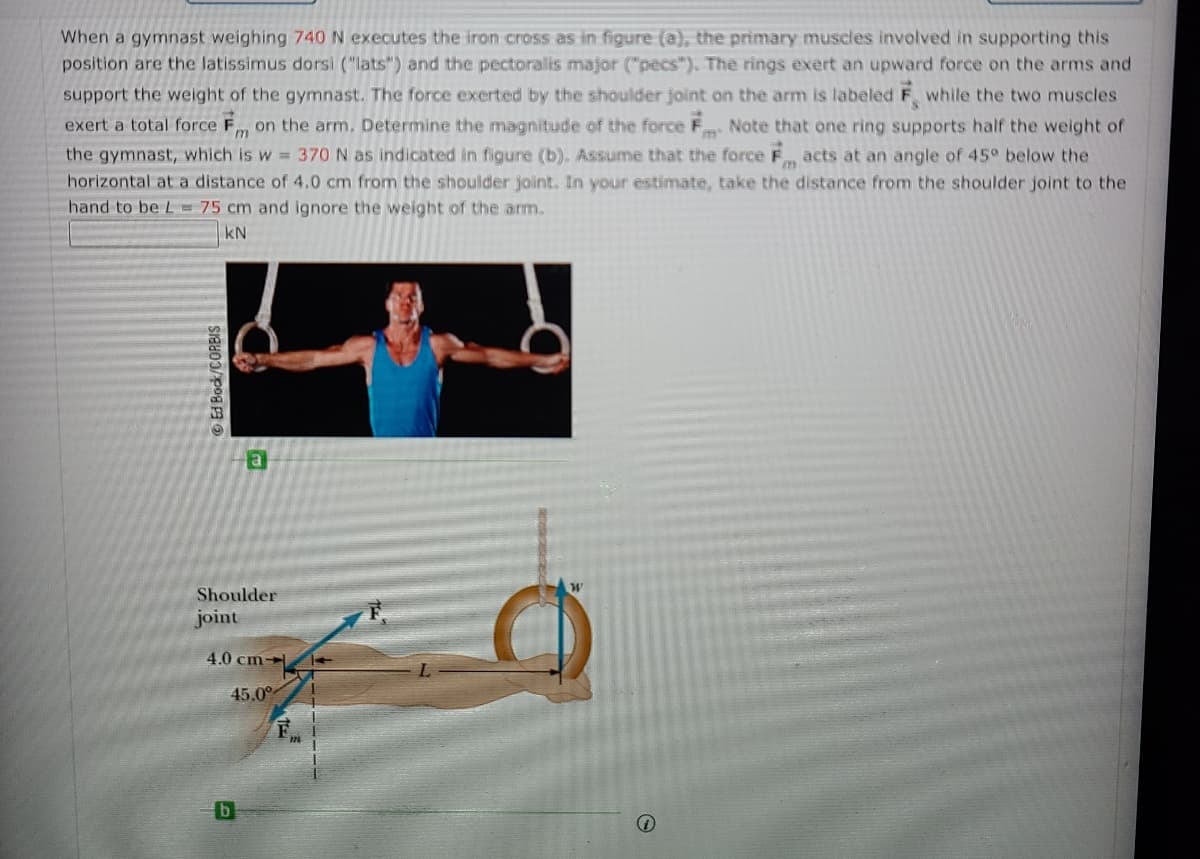When a gymnast weighing 740 N executes the iron cross as in figure (a), the primary muscles involved in supporting this position are the latissimus dorsi ("lats") and the pectoralis major ("pecs"). The rings exert an upward force on the arms and support the weight of the gymnast. The force exerted by the shoulder joint on the arm is labeled F while the two muscles exert a total force F on the arm. Determine the magnitude of the force Fm Note that one ring supports half the weight of the gymnast, which is w 370 N as indicated in figure (b). Assume that the force F acts at an angle of 45° below the horizontal at a distance of 4.0 cm from the shoulder joint. In your estimate, take the distance from the shoulder joint to the hand to be L = 75 cm and ignore the weight of the arm. kN
When a gymnast weighing 740 N executes the iron cross as in figure (a), the primary muscles involved in supporting this position are the latissimus dorsi ("lats") and the pectoralis major ("pecs"). The rings exert an upward force on the arms and support the weight of the gymnast. The force exerted by the shoulder joint on the arm is labeled F while the two muscles exert a total force F on the arm. Determine the magnitude of the force Fm Note that one ring supports half the weight of the gymnast, which is w 370 N as indicated in figure (b). Assume that the force F acts at an angle of 45° below the horizontal at a distance of 4.0 cm from the shoulder joint. In your estimate, take the distance from the shoulder joint to the hand to be L = 75 cm and ignore the weight of the arm. kN
College Physics
10th Edition
ISBN:9781285737027
Author:Raymond A. Serway, Chris Vuille
Publisher:Raymond A. Serway, Chris Vuille
Chapter8: Rotational Equilibrium And Rotational Dynamics
Section: Chapter Questions
Problem 85AP: The Iron Cross When a gymnast weighing 750 N executes the iron cross as in Figure lN.91a, the...
Related questions
Concept explainers
Rotational Equilibrium And Rotational Dynamics
In physics, the state of balance between the forces and the dynamics of motion is called the equilibrium state. The balance between various forces acting on a system in a rotational motion is called rotational equilibrium or rotational dynamics.
Equilibrium of Forces
The tension created on one body during push or pull is known as force.
Question

Transcribed Image Text:When a gymnast weighing 740 N executes the iron cross as in figure (a), the primary muscles involved in supporting this
position are the latissimus dorsi ("lats") and the pectoralis major ("pecs"). The rings exert an upward force on the arms and
support the weight of the gymnast. The force exerted by the shoulder joint on the arm is labeled F while the two muscles
exert a total force F on the arm. Determine the magnitude of the force F Note that one ring supports half the weight of
the gymnast, which is w 370 N as indicated in figure (b). Assume that the force F acts at an angle of 45° below the
horizontal at a distance of 4.0 cm from the shoulder joint. In your estimate, take the distance from the shoulder joint to the
hand to be L = 75 cm and ignore the weight of the arm.
m
kN
Shoulder
joint
4.0 cm-
45.00
Ed Bock/CORBIS
Expert Solution
This question has been solved!
Explore an expertly crafted, step-by-step solution for a thorough understanding of key concepts.
This is a popular solution!
Trending now
This is a popular solution!
Step by step
Solved in 4 steps

Knowledge Booster
Learn more about
Need a deep-dive on the concept behind this application? Look no further. Learn more about this topic, physics and related others by exploring similar questions and additional content below.Recommended textbooks for you

College Physics
Physics
ISBN:
9781285737027
Author:
Raymond A. Serway, Chris Vuille
Publisher:
Cengage Learning

College Physics
Physics
ISBN:
9781305952300
Author:
Raymond A. Serway, Chris Vuille
Publisher:
Cengage Learning

College Physics
Physics
ISBN:
9781285737027
Author:
Raymond A. Serway, Chris Vuille
Publisher:
Cengage Learning

College Physics
Physics
ISBN:
9781305952300
Author:
Raymond A. Serway, Chris Vuille
Publisher:
Cengage Learning